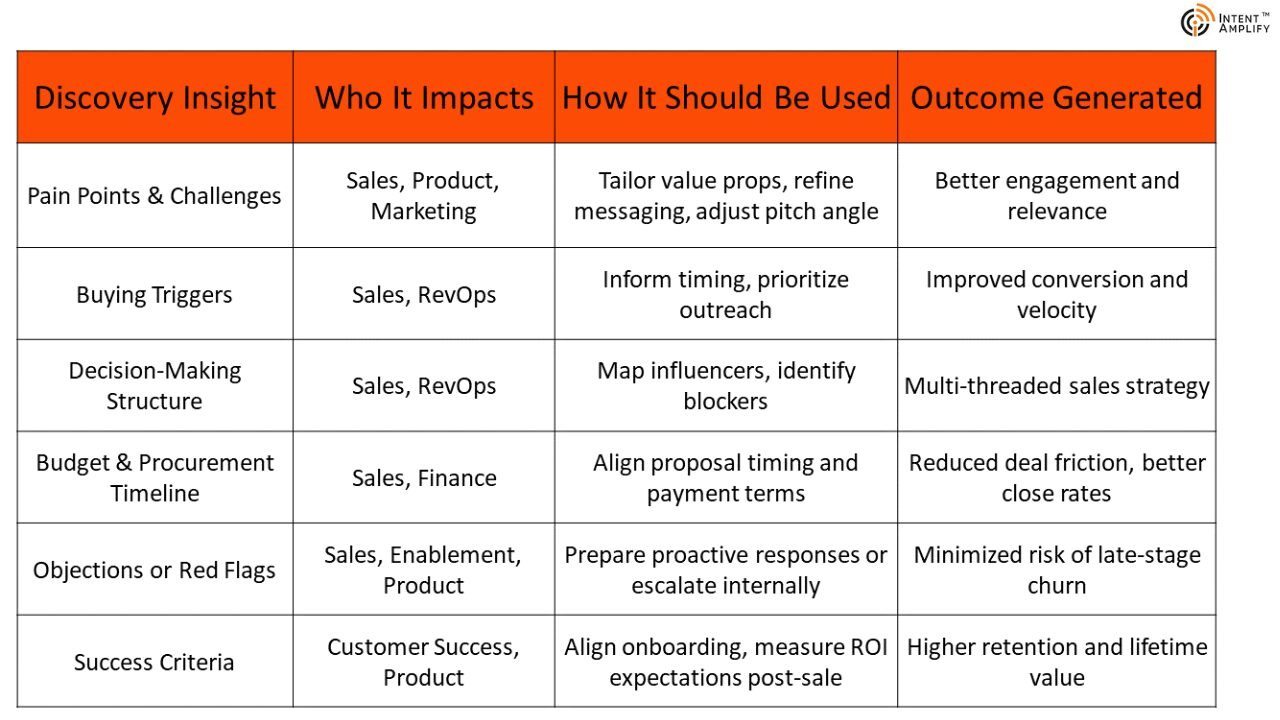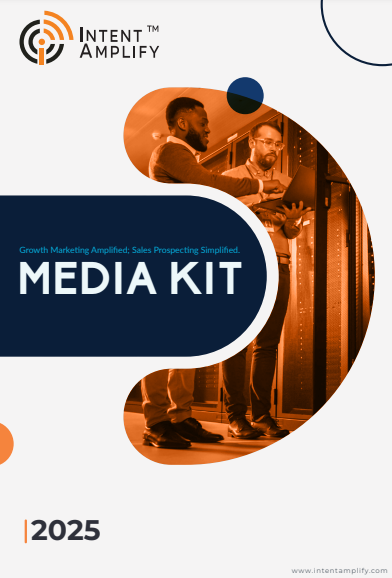
What Are B2B Discovery Calls? How They Help Convert Smarter
- Last updated on: July 29, 2025
B2B Discovery Calls represent one of the first substantial contact points between a sales team and a would-be customer.
In contrast to a cold pitch or product demo, a discovery call is not intended to sell but to learn.
It’s a calculated dialogue that assists in discovering a prospect’s true needs, pain points, and priorities, before any solutions are presented. In the modern B2B world, where buyers research extensively before ever talking to sales, discovery calls are even more essential.
They’re your key to understanding the buyer’s universe, and what they require isn’t just what, but why. Executed well, they set up a foundation for smarter, more targeted follow-ups and dramatically higher conversion rates.
Rather than counting on assumptions, sales teams can customize their strategy based on actual buyer intent and context gleaned during these initial conversations. In an era where personalization, velocity, and trust lead B2B decisions, that’s a significant competitive advantage.
This post delves into what B2B discovery calls are, why they’re important, and how they can enable sales teams to convert better by hearing first and selling second.
Before we dive into how discovery calls assist in converting smarter, it’s worth noting what they are and how they differ from other early-stage sales conversations.
What Is a B2B Discovery Call?
A B2B discovery call is the initial strategic dialogue between sales and a prospective buyer. It’s not pitching a solution. It’s discovering what matters and doing so quickly.
The objective is to grasp the prospect’s needs, not sell them.
The Following are the five foundational elements that drive a successful B2B discovery call:
-
Qualification over persuasion
Discovery is not where you “sell” your solution. It’s where you qualify if there’s a mutual value in even having a conversation.
The top reps center around listening to the business problem, timeline, decision process, and urgency.
This guards your pipeline against overpromising and keeps you from chasing leads who were never a fit to start with. From the buyer’s side, it also takes pressure off and establishes trust early.
-
Context-rich questions
Strong discovery is driven by curiosity, not a script. Instead of generic prompts, seasoned reps ask layered questions like:
“What led your team to explore this now?”
“What’s been tried, and why hasn’t it worked?”
These open up dialogue and reveal the emotional and strategic triggers behind the business challenge. For the buyer, it signals that you’re here to understand, not just to pitch.
-
Intent-driven timing
Discovery is most effective when scheduled around actual engagement.
Perhaps the prospect downloaded a whitepaper, browsed a price page, or was signaled by intent. That digital activity indicates preparedness. When reps reach out at the right time, the conversation doesn’t come across as forced. The buyer perceives it as timely, not arbitrary.
-
Insight gathering
Beyond surface-level pain points, excellent discovery reveals internal dynamics.
Who is involved in the decision? Is there an official buying process? Competing priorities or legacy tools?
These facts determine how you move through the account and enable you to customize every next step afterward. For the buyer, it prevents them from having to repeat themselves on future calls.
-
Relationship building
The discovery call is probably the buyer’s first real-life impression of your company.
It’s setting the tone. When you arrive prepared, start with empathy, and remain present the whole time through, you start to build credibility.
That relationship won’t close the deal for you, yet it opens the door to further, more strategic dialogue later.
When designed with a purpose, a discovery call can be more than a sales checkpoint; it can be a moment to build trust. It distinguishes between genuine opportunity and misalignment and sets the stage for wiser, more efficient selling to come.
Key Components of a Successful Discovery Call
A discovery call is not another check in the box in the sales process. It’s your one opportunity to learn about the buyer before giving something in return. In B2B, where transactions are complicated and sales cycles are lengthy, context matters. A good discovery call assists reps in dispelling presumptions, discovering real business requirements, and winning the right to discuss further.
Here are the important factors that propel a high-quality discovery experience, one that serves both the buyer and the sales team.
-
Qualification over persuasion
The top salespeople understand that they’re not there to push products forward; they’re there to filter.
The discovery call should assess if the account is worth pursuing, by business fit, by urgency, and by readiness.
This saves your team time and keeps your pipeline clean. It also opens up room to disqualify early, avoiding both parties from wasting effort on a bad fit.
-
Context-rich questions
Smart discovery is not about box-checking. It’s about asking multi-layered, open-ended questions that yield genuine friction points.
Questions such as “What internal obstacles are hindering this effort?” or “What success would look like in your opinion?” create insights you won’t find in a form fill. These answers are the foundation of your value proposition, and they can’t be fabricated.
-
Intent-driven timing
Discovery calls are not random calls. They must come after some indicator of buyer interest, whether a whitepaper download, high-fit scoring, or third-party intent data.
If the lead comes into the funnel with digital body language already engaged, the call is a continuation of a conversation the buyer has already begun in their mind. That timing makes all the difference.
-
Insight gathering
Good discovery opens up more than pain; it opens up priorities, constraints, timelines, and political dynamics.
Reps need to ask about the buying process, who approves the budget, and if there’s a competing project that could blow the deal. These answers don’t merely qualify; they direct strategy for each follow-up phase.
-
Relationship building
At its essence, a discovery call is a human moment. It’s an uncommon opportunity to demonstrate to the buyer that you’re not yet another transactional rep.
When you listen, reflect their language, and demonstrate you’ve done your research, you transition from vendor to advisor. That transition is important in enterprise B2B, where trust is frequently the largest conversion factor.
Combined, these components transform a discovery call from a process step to a strategic tool. It’s not merely about making it to the next meeting; it’s about initiating the correct conversation with the correct individual for the right purpose.
How Discovery Calls Drive Smarter Conversions
It was discovered in a recent ASG buyer survey that 67% of B2B buyers rate discovery as the most important aspect of the sales process. They anticipate that sales reps will pace themselves, learn about their real challenges, and validate impact before they bring any solution to them.
From the perspective of the buyer, discovery calls are different. They are not pitches masquerading as discovery; they’re real efforts to get to know. And the outcome? Greater alignment, fewer dead-ends, and better-quality conversions.
Here’s how discovery calls bring real impact:
-
Prioritized, high-fit pipelines
Buyers increasingly traverse complicated inner worlds. Discovery enables reps to determine readiness, pain relevance, and scope of decision early on, ensuring that time is invested in actual opportunities. Prospects value the prioritization, and sales teams save bandwidth from investing in improbable deals.
-
Customized value propositions
When reps match their words and examples to what buyers have previously communicated, messaging doesn’t come off as templated but rather as customized. In a recent study, 82% of buyers ranked credibility above likability, appreciating reps who speak with relevance and insight.
-
Deal velocity is accelerated
The finding that reveals surface urgency, stakeholder dynamics, and budget frameworks shortens the decision path.
When expectations are clear up front, buyers proceed with greater confidence.
90% of B2B buyers, says Gitnux, know what they need before they meet with a salesperson, so misaligned pitches can be a deal killer.
-
Less friction later
Complaints about authority, timing, or boundaries usually blow up deals at the last minute. Discovery allows these to be brought up early, so reps have an opportunity to mitigate risks upfront. That proactive stance establishes credibility and eases subsequent phases.
-
Intelligent sales forecasting
Unclear lead information results in murky forecasts.
Discovery calls provide clarity regarding intent, fit, and timing, and provide leadership assurance in deal health. That openness facilitates improved coaching, resource planning, and pipeline hygiene.
At its essence, discovery is not data collection; it’s deal formation. These calls turn the discussion from reactionary to responsive. They engage prospects as active participants and assumptions as actionable insight.
Common Mistakes to Avoid During Discovery Calls
Bryan Gray, Revenue Path Group CEO and co-author of The Priority Sale, distills it nicely:
“A discovery call should be about: How do I best understand your priorities and what you really need in a way that allows me to find the best fit between our organizations?”
This is the ideal introduction: discovery isn’t a transaction, it’s a translation. But too many reps sabotage this all-important phase with errors that annoy buyers and conceal actual opportunities. In the sections below, we cover six high-cost blunders and alternatives.
Mistake 1: Speaking Too Much, Listening Too Little
When reps talk more than they listen, buyers get ignored. Too many calls turn into product demonstrations disguised as “discovery.” It kills curiosity and trust.
The solution: Don’t try to show off your expertise. Start with open-ended questions. Use silence to get them to elaborate. Work to get the buyer to talk at least 50–60% of the time. Pivoting to insightful answer-based responses should only happen after that.
Mistake 2: Mixing Discovery With a Demo
Mixing discovery and demo phases tends to shortchange both. Discovery is made superficial, and the demo becomes a monologue. That leaves minimal space to qualify fit or discover actual priorities.
The solution: Keep these phases separate. Determine if a demo is even needed. If fit is present, plan the demo following discovery when it has already substantiated budget, timeline, and stakeholder commitment.
Mistake 3: Skimming with Low-Depth Questions
Surface-level questioning can come across as perfunctory, not inquiring. A scatterbrained approach rushes past root causes and underlying challenges.
The solution: Go one step deeper. When problems occur, turn to questions such as, “Why do you think that issue recurs?” or “How has that affected your metrics?” Depth in succession provides better insights.
Mistake 4: No Preparation
When reps arrive unprepared and uninformed, they waste the prospect’s time. Buyers know when questions are canned or answered on their website.
The solution: Take 10–15 minutes looking at LinkedIn profiles, company news, or intent data. Begin with a thoughtful observation. Prepared thinking communicates respect and earns you credibility.
Mistake 5: Questioning Instead Of Discussing
Yes/no questions fired in rapid succession turn discovery into interrogation. That technique shuts down conversation and suspends trust.
The solution: Start a conversation with light, open-ended questions. Reflect tone and tempo. Establish rapport first through insight-sharing and then progress to more in-depth diagnostic questioning. Get it to feel like a partnership, not an interrogation.
Mistake 6: Not Recapitulating and Checking for Alignment
Most reps launch into the next step without recapitulating what was said. That can cause misalignment on pain, priority, or next step.
Solution: End the call with, “Let me recap what I heard, tell me what I missed or got wrong.” Then wait. Follow up via a brief email summary after the call. Establish alignment before the next step.
Discovery errors aren’t simply strategic communication-wise; they send messages. When you mess up discovery, the message you send to the buyer is that you’re more interested in closing than fixing.
When done with structure, empathy, and clarity, discovery is your strongest qualifying tool and trust-builder on the first call.
Mistakes avoided are merely half the fight. The true benefit of a discovery call is what you make of the insights gleaned. Once those insights are documented, distributed, and driven throughout your sales motion, they become a differentiator, rather than just dialogue.
Embedding Discovery Call Insights into the Sales Process
A discovery call is only worth as much as the follow-up action. But in too many B2B companies, what’s revealed on the call never gets across to the rest of the sales process. Notes remain isolated. CRMs remain partially completed. And marketing, product, and leadership teams fail to capture critical buyer signals.
To convert better, sales teams have to approach discovery insights not as discrete inputs—but as dynamic, shareable intelligence that informs the end-to-end cycle. Properly executed, this integration enhances sales performance, enhances messaging precision, and shores up forecasting.
This is how discovery insights ought to flow throughout the sales process:
How to Make This Flow Work
1. Log insights in CRM in real time.
Don’t rely on memory or scribbled notes. Use structured fields, dropdowns, or tagging where possible. Rich call notes are only useful if they’re accessible to the team.
2. Sync with marketing to close the loop.
When marketing knows the real language and themes prospects are using, content becomes sharper. This improves pre-funnel messaging and post-call nurture assets.
3. Enable RevOps to improve scoring and forecasting.
Discovery patterns, such as recurring blockers or deal speed triggers, can enhance lead scoring models, playbooks, and pipeline forecasting.
4. Pass insights to Product & Success teams.
Discovery doesn’t merely close deals—it guides what customers require after the sale. Churn-reducing, retention-strengthening teams listen from day one.
5. Create templates that invite reflection.
Build templates for reps to report back on each discovery call. A straightforward 5-point summary: Pain, Urgency, Fit, Next Steps, Internal Dynamics, discussed in deal rooms, CRM, or Slack channels, keeps everyone on the same page.
Discovery insights shouldn’t be confined to siloed call recordings or hidden in follow-up emails. When they flow easily through your go-to-market stack, they revolutionize the way you sell, market, and retain. It’s not merely about knowing the buyer, it’s about ensuring everyone else does as well.
Why This Matters Now
The B2B selling environment is busier and more complicated than ever before.
A Forrester survey found that 74% of B2B buyers conduct more than half of their research online before engaging with a sales representative.
Discovery calls give you the edge:
Differentiation through dialogue.
Most competitors are skipping discovery or rushing it. The strong discovery stands out; it reframes the conversation from selling to understanding—and lets you shape the buying narrative.
Team alignment around reality.
Discovery turns assumptions into evidence. When insights are shared across marketing, product, RevOps, and customer success, your entire GTM engine becomes smarter and more consistent.
Lower churn, higher value.
Sales teams that begin with discovery are more likely to close deals that stick. You’ve aligned expectations, proven relevance, and softened the path for delivery and adoption.
Conclusion: Discovery Calls Are The Beginning of Strategic Edge
B2B discovery calls are much more than a check-the-box or a sales milestone. They are where intent meets relevance, where curiosity, context, and qualification inform wiser selling.
We discussed what discovery calls are and why they are important. The most important pieces that drive them to succeed, the most frequent pitfalls that derail them, and how to apply their findings across your funnel.
In the article we also witnessed how they have a direct effect on conversion speed, forecast precision, and long-term customer fit.
In today’s complex, buyer-influenced environment, discovery calls are no longer a nice-to-have; they’re a strategic advantage.
They enable you to:
- Listen before you propose.
- Qualify before you pursue.
- Align before pitching.
And finally, they enable you to sell smarter, not harder.
Lead with insight. Close with confidence. Win with relevance.
Because in B2B, how you begin the conversation tends to determine how you complete it.
FAQs
1 . Can discovery calls be scaled without sacrificing personalization?
Yes, with the right frameworks. Applying call templates, guided CRM fields, and insight-sharing workflows enables sales teams to scale discovery while remaining human and relevant.
2. What’s the most egregious error reps commit during discovery?
Talking too much. The most frequent error is taking over the conversation rather than listening. Great reps make room for the buyer to talk—and then drill deeper with follow-ups.
3. Should you tie a discovery call together with a demo?
No. Discovery and demo must be kept as distinct phases. Combining them tends to create hurried qualifications and boring demos. It’s advisable to establish need and fit prior to solution presentation.
4. How long should a discovery call be?
Optimal discovery calls range from 20 to 40 minutes, based on deal size and the complexity of the buyer. The best approach is quality—not quantity—of information shared.
5.When should a discovery call occur in the sales process?
Discovery generally occurs after a lead exhibits intent—such as through filling out a form, downloading material, or responding to outbound outreach. It’s the connection between marketing qualification and more intense sales engagement.




